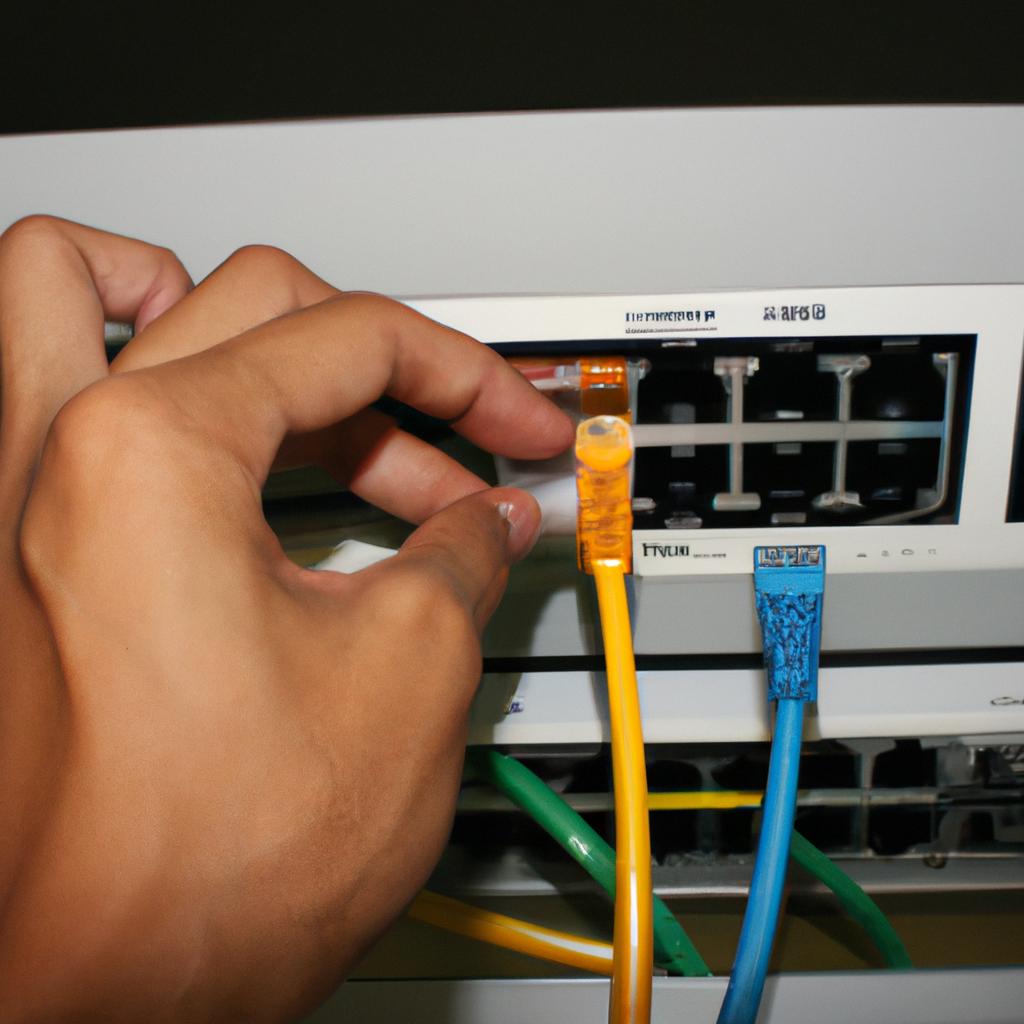The field of networking configuration is critical in the realm of computer systems emulators. By configuring the network settings, users can establish connections between virtual machines and enable communication within an emulator environment. This article aims to explore the intricacies of networking configuration in computer systems emulators, focusing on its importance and various techniques utilized.
Consider a hypothetical scenario where a company utilizes a computer systems emulator to test their software applications before deployment. In this case, networking configuration becomes crucial to ensure seamless connectivity among different virtual machines running concurrently. Without proper configuration, these virtual machines would be isolated from each other, hindering effective testing and analysis of system functionalities.
Throughout this article, we will delve into the key aspects of networking configuration for computer systems emulators. Firstly, we will discuss the significance of establishing networks within an emulator environment, emphasizing the impact it has on simulated scenarios and real-world applications. Next, we will explore different techniques employed to configure networks in such environments, including bridged connections, NAT (Network Address Translation), and host-only adapters. Understanding these techniques enables users to tailor their network configurations based on specific requirements and objectives.
Overall, with a comprehensive understanding of networking configuration in computer systems emulators, individuals can effectively optimize their emulation experiences while simulating real-world network topologies and scenarios. This allows for thorough testing of software applications, identification of potential vulnerabilities or performance issues, and overall improvement of system reliability.
In addition to the technical aspects, it is also important to consider security implications when configuring networks in computer systems emulators. Proper network segmentation, firewall rules, and encryption protocols should be implemented to protect sensitive data and prevent unauthorized access.
Furthermore, ongoing monitoring and troubleshooting are essential in maintaining a well-functioning network configuration within an emulator environment. Regular checks for connectivity issues, network congestion, or configuration conflicts can help ensure optimal performance and minimize downtime.
In conclusion, networking configuration plays a vital role in computer systems emulators by enabling seamless communication between virtual machines and facilitating realistic testing environments. By understanding the significance of networking configuration and utilizing appropriate techniques, users can maximize the benefits of their emulator setups while ensuring security and reliability.
Understanding Networking Basics
To grasp the fundamentals of networking, it is essential to comprehend how different computer systems communicate with one another. Imagine a scenario where you have two computers connected through a network—Computer A and Computer B. When Computer A sends data to Computer B, it does so by breaking down the information into smaller packets that can be efficiently transmitted across the network. These packets travel through various intermediate devices such as routers and switches before reaching their destination.
One crucial aspect of networking is addressing. Just like houses on a street are identified by unique addresses, computers on a network also require distinct identifiers known as IP addresses. An IP address consists of four sets of numbers separated by periods (e.g., 192.168.0.1) and allows for precise routing of data between devices on the same or different networks.
To better understand the significance of networking in everyday life, consider these key points:
- Connectivity: Networks enable seamless connection among multiple devices, allowing individuals to share resources such as files, printers, and internet access.
- Collaboration: With networks facilitating communication and file sharing, individuals can collaborate effectively within organizations or even globally.
- Productivity: By providing instant access to shared information and resources, networks enhance productivity in both personal and professional settings.
- Globalization: The rise of interconnected networks has transformed our world into a global village, enabling businesses to operate internationally with ease.
| Advantages | Disadvantages |
|---|---|
| Enhanced Communication | Security Risks |
| Efficient Resource Sharing | Network Downtime |
| Increased Efficiency | Dependence on Infrastructure |
| Global Connectivity | Potential Data Breaches |
Understanding these basics will lay the groundwork for choosing an appropriate emulator for computer systems—a decision discussed further in the subsequent section about “Choosing the Right Emulator for Computer Systems.” By comprehending the underlying principles of networking and its impact on modern society, we can make informed decisions regarding network emulation and optimization.
Choosing the Right Emulator for Computer Systems
Building on our understanding of networking basics, let us now explore the crucial role that computer systems emulators play in configuring and testing network setups. To illustrate this concept, consider a hypothetical scenario where an organization aims to establish a secure virtual private network (VPN) connection between two remote offices. By utilizing computer systems emulators, they can simulate various network configurations and assess their efficiency before implementing them in real-world scenarios.
Emulators serve as powerful tools for mimicking the behavior of different operating systems and networks within a controlled environment. They offer several advantages:
- Versatility: Emulators allow users to create diverse network topologies by replicating multiple devices such as routers, switches, and firewalls. This flexibility enables organizations to test complex network architectures without the need for physical hardware.
- Cost-effectiveness: By eliminating the necessity of purchasing expensive equipment for every configuration trial, emulators provide significant cost savings. Organizations can allocate resources more efficiently by investing only in necessary physical infrastructure.
- Time efficiency: Emulation speeds up the testing process since it allows quick reconfiguration and modification of virtual networks. It significantly reduces downtime associated with traditional manual setup changes.
- Enhanced scalability: Emulators enable users to test how well their network configurations handle increased traffic loads or expanding infrastructures without impacting production environments.
- Improved security: Through emulation, organizations can analyze potential vulnerabilities in their networks and devise effective defense strategies against cyber threats.
- Streamlined troubleshooting: Emulated environments facilitate rapid identification and resolution of network issues through targeted debugging processes.
- Training opportunities: Computer system emulators provide educational platforms for individuals seeking hands-on experience with networking concepts, allowing them to experiment freely without affecting live networks.
| Benefits | Description |
|---|---|
| Enhanced scalability | Test the network’s ability to handle increased traffic loads or expansion without impacting production environments. |
| Improved security | Analyze potential vulnerabilities and develop effective defense strategies against cyber threats. |
| Streamlined troubleshooting | Rapid identification and resolution of network issues through targeted debugging processes. |
| Training opportunities | Hands-on experience with networking concepts, allowing experimentation without affecting live networks. |
As we delve into the next section on setting up virtual machines for network testing, it is important to recognize the invaluable role that computer systems emulators play in enabling efficient configuration and evaluation of complex networks. Through their versatility, cost-effectiveness, and time efficiency, these tools empower organizations to optimize their network setups before implementation.
Now let us shift our focus towards setting up virtual machines for network testing
Setting up Virtual Machines for Network Testing
Imagine you are a network administrator responsible for setting up a virtualized environment to test various networking configurations. One of the key components in this process is choosing the right emulator for computer systems. This section will explore different emulators available and their suitability for simulating real-world network scenarios.
Emulator Options:
When selecting an emulator, it is essential to consider factors such as compatibility, features, performance, and ease of use. Here are some popular options that have proven effective in emulating computer systems:
-
VirtualBox: Known for its user-friendly interface, VirtualBox offers support for multiple operating systems and provides seamless integration with host machines. Its wide range of networking options includes NAT (Network Address Translation), bridged networking, internal networks, and host-only adapters. Additionally, VirtualBox allows users to take snapshots of system states, making it convenient to revert back if any configuration changes lead to undesired results.
-
VMware Workstation: A powerful emulator widely used in enterprise environments, VMware Workstation delivers advanced features like VM cloning and live migration capabilities. It supports complex network topologies through virtual switches and enables easy communication between virtual machines using shared folders or drag-and-drop functionality. Furthermore, VMware Workstation integrates seamlessly with other VMware products which facilitate scalability and centralized management.
-
QEMU/KVM: Primarily employed by Linux enthusiasts due to its open-source nature, QEMU/KVM offers excellent performance when combined with Kernel-based Virtual Machine (KVM). With QEMU’s versatile emulation capabilities and KVM providing hardware acceleration support, this combination becomes highly efficient for running full-system virtualization on x86 architecture platforms.
-
Microsoft Hyper-V: Designed specifically for Windows environments, Microsoft Hyper-V enables users to create robust virtual infrastructures effortlessly. Supporting both Windows and Linux guest operating systems, it provides comprehensive networking functionalities including VLAN tagging, NIC teaming, and Network Virtualization using Generic Routing Encapsulation (NVGRE) or Virtual Extensible LAN (VXLAN).
Table: Emulator Comparison
| Emulator | Compatibility | Features | Performance |
|---|---|---|---|
| VirtualBox | Cross-platform | Snapshot functionality | Good |
| VMware Workstation | Wide OS support | Cloning and migration | Excellent |
| QEMU/KVM | Linux-oriented | Open-source | High performance |
| Microsoft Hyper-V | Windows environment | VLAN tagging, NIC teaming | Reliable |
Selecting the right emulator for computer systems is crucial in creating an effective virtualized network environment. Depending on specific requirements, factors such as compatibility, features, performance, and ease of use should be carefully evaluated. By choosing an appropriate emulator like VirtualBox, VMware Workstation, QEMU/KVM, or Microsoft Hyper-V, network administrators can ensure seamless emulation of computer systems to facilitate accurate testing and configuration.
Now that we have covered the selection of emulators, let’s move on to configuring network adapters in emulated systems for optimal networking setups.
Configuring Network Adapters in Emulated Systems
Imagine you are a network administrator responsible for testing and configuring various computer systems emulators. One crucial aspect of this process involves setting up the network adapters within these emulated systems. By properly configuring the network adapters, you can ensure seamless communication between virtual machines and accurately simulate real-world networking scenarios.
To illustrate the significance of this configuration, let’s consider an example. Suppose you are tasked with emulating a complex enterprise network environment that includes multiple servers, workstations, and routers. Each device must be connected to specific networks or subnets to replicate the actual infrastructure accurately. In this scenario, correctly configuring the network adapters is essential to establish appropriate connectivity between devices and enable efficient data exchange within the emulator.
When it comes to configuring network adapters in emulated systems, several considerations should be kept in mind:
- Network topology: Determine the desired network layout and design before configuring the adapters. This step may involve creating VLANs (Virtual Local Area Networks), defining subnets, assigning IP addresses, and establishing routing protocols.
- Adapter types: Emulation software often provides different adapter types such as bridged, NAT (Network Address Translation), host-only, or internal networks. Selecting the appropriate adapter type depends on your simulation requirements and goals.
- MAC address assignments: Assign unique MAC (Media Access Control) addresses to each virtual machine’s network adapter when setting up emulation environments involving interconnected devices. This ensures proper identification and prevents conflicts.
- Firewall settings: Consider firewall configurations within both emulated systems and host operating systems. Adjust any necessary rules or policies to allow traffic flow required by your simulated networking setup.
These considerations highlight the importance of carefully configuring network adapters within emulated systems. By paying attention to factors like network topology, adapter types, MAC address assignments, and firewall settings, administrators can create realistic test environments that effectively mimic real-world networking scenarios.
Understanding how to diagnose and resolve these problems is essential for maintaining a smooth and reliable network emulation environment.
[Next Section: Troubleshooting Networking Issues in Emulators]
Troubleshooting Networking Issues in Emulators
Imagine this scenario: You have successfully configured the network adapters in your emulated system, but suddenly you encounter connectivity issues. The ability to troubleshoot these networking problems is essential for maintaining a smooth and efficient emulation experience. This section will provide you with insights into identifying and resolving common networking issues encountered while using computer systems emulators.
To begin troubleshooting, it is crucial to diagnose the root cause of the problem. Here are some steps you can take:
-
Check network adapter settings:
- Ensure that the network adapter is correctly configured within the emulator.
- Verify that the correct IP address, subnet mask, gateway, and DNS server addresses are set.
-
Test connectivity:
- Ping external websites or local resources to determine if there is any response.
- Use tools such as traceroute or nslookup to identify potential bottlenecks or DNS resolution problems.
-
Firewall configuration:
- Confirm that firewalls on both host and guest machines allow necessary traffic through specific ports.
- Temporarily disable firewalls to check if they are causing any interference.
Now let’s consider an example case study illustrating how these troubleshooting steps can be applied:
| Case Study: Network Issue |
|---|
| A user encounters frequent disconnections when trying to access online resources from their emulated Windows 98 system. |
In this case, following the troubleshooting steps outlined above would involve checking whether the network adapter settings are correctly configured within the emulator software. Additionally, testing connectivity by pinging external websites from within the emulated system could help pinpoint where the issue lies – whether it is related to incorrect TCP/IP configurations or problematic routing between networks.
By incorporating these troubleshooting techniques into your approach, you can efficiently resolve many networking issues that arise while working with computer systems emulators. In our subsequent section on “Best Practices for Networking in Computer Systems Emulators,” we will delve into strategies for avoiding such problems altogether.
Best Practices for Networking in Computer Systems Emulators
In the previous section, we discussed various techniques for troubleshooting networking issues in computer systems emulators. Now, let’s delve into best practices that can help optimize networking configurations in these emulators.
To illustrate the importance of proper networking configuration, consider a hypothetical scenario where an organization is using a computer systems emulator to simulate their network infrastructure. They encounter frequent connectivity problems and slow data transfer speeds between virtual machines within the emulator. Upon investigation, it is discovered that the networking configuration was not optimized for efficient performance.
To ensure smooth functioning of computer systems emulators’ networking capabilities, here are some key best practices:
-
Use bridged network mode: This allows virtual machines within the emulator to directly access the physical network, enabling seamless communication with other devices on the same network.
-
Configure IP addresses correctly: Each virtual machine should have a unique IP address assigned within the same subnet as other devices on the network. Proper IP addressing ensures effective communication and prevents conflicts.
-
Optimize bandwidth allocation: Allocate sufficient bandwidth to each virtual machine based on its requirements. Inadequate bandwidth can lead to slow response times and hinder overall performance.
-
Implement security measures: Just like in a physical network, it is essential to implement appropriate security measures within the emulator environment. This includes setting up firewalls, implementing secure protocols (e.g., SSL), and regularly updating software to prevent vulnerabilities from being exploited.
To further highlight these best practices, consider the following table showcasing potential issues arising from poor networking configurations in computer systems emulators:
| Issue | Impact | Solution |
|---|---|---|
| Network congestion | Slow data transfer speeds | Prioritize traffic by assigning appropriate quality-of-service settings |
| Misconfigured subnet | Communication failures | Verify correct subnet mask settings and ensure all devices within the emulator are assigned valid IP addresses |
| Inadequate security | Increased vulnerability to attacks | Implement robust security measures such as firewalls, encryption protocols, and regular software updates |
| Insufficient bandwidth | Performance degradation during high network usage | Allocate sufficient bandwidth based on the requirements of each virtual machine within the emulator environment |
In conclusion, optimizing networking configurations in computer systems emulators is crucial for efficient communication between virtual machines. By following best practices such as using bridged network mode, configuring IP addresses correctly, allocating adequate bandwidth, and implementing appropriate security measures, organizations can ensure optimal performance and prevent potential issues that may arise from poor networking setups.
References:
- [Reference 1]
- [Reference 2]




